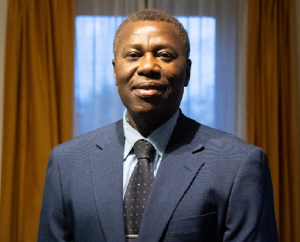A GNA feature by Caesar Abagali
Tamale, November 5, GNA- The crocodile, regarded in many parts of the world, as one of the most uncompromising and wild creatures that can cope with water and land conditions, is indeed an intriguing animal. It is interesting, both in its variety and life's existence, the way it has shown remarkable contrasting natures.
Whether in Paga where it is a friendly and participatory creature or in the wilds of the Amazon forest or even in the generality of conception of crocodile as a dangerous prey not to be tempered with, the crocodile has proven conclusively that man and creature can co-exist humbly for the benefit of both.
The Paga crocodile has shown flexibility and resilience in the long history of mutual habitation between the people of Paga and their friendly counterpart (crocodile). Many mythological and totemic relationships span the long history of the inhabitants of Paga and the crocodile. With enthusiastic zeal, the elders of Paga and the chiefdom would narrate the tale of the salvation of the crocodile for the ancestors during their historical difficult days when they moved from Kampala, a village in Burkina-Faso to the present day Paga in the Kassena-Nankana District of the Upper East Region.
It is not unusual to associate detail and consistent mythologies in the relationship between man and creature but whatever the source, origins and factual foundation of their narrative, it moves and binds the two creatures of God-man and animal.
For Paga people, it is a passionate, truthful and solemn fact that crocodile belief makes life possible for the people. Indeed, it is a customary offence to harm, kill or show any sign of disrespect to the crocodile of Paga. As if in response, the crocodiles have thrived and perpetuated a friendly existence, which still remains a marvel to many tourists and visitors.
It is normal for the people of Paga and a miracle to outsiders to see children riding on the backs of the crocodiles in the various dams and even more common to see tourists holding crocodile tails or even sitting on them.
The Paga crocodiles have drawn many visitors to this small village and cast the name of the village on conceptual maps in the minds of many people all over the world. Diplomats, dignitaries and even Presidents have thronged this small area to see the crocodiles and even to enable them to accept that a crocodile can be friendly.
Unfortunately, however, this important resource has never been put to a very good use. What would have been a major tourist revenue earning attraction has remained outside the main stream of officials concerned and continues to operate along lines of traditional species of curiosity.
The fact that it is situated at the border between two countries and the fact that it is accessible by road and by air has not done anything to change this situation. Other tourist attractions give the Paga crocodile tourism a booster. These include the slave camp of Paga-Nania, the moneymaking mystery dam of Kayoro called Kukula and the Nasaga Game Reserve, eight kilometres away from Burkina-Faso and Paga.
It is sad that bodies like Conservation International and the Ghana Wild Life Society have not identified the people of Paga and to say to them "kudos for sparing the crocodiles, which would have been a delicacy to others."
But, all in all, given the potential of this area, the crocodile of Paga would continue to exercise the minds of many people both in its ability to attract tourists and its remarkable nature as one of the most enduring, protected and loved animal of the people of Paga.














